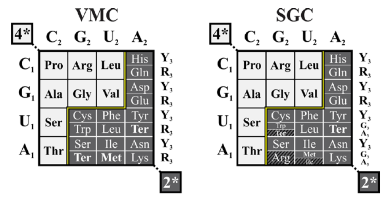
STANDARD GENETIC CODE: P-ADIC MODELLING, NUCLEON BALANCES AND SELFSIMILARITY
Abstract
Keywords
Full Text:
PDFReferences
SZATHMÁRY, E.: The origin of the genetic code: amino acids as cofactors in an RNA world. Trends Genet. 15 (1999) 223-229.
KNIGHT, R.D., FREELAND, S.J., LANDWEBER, L.F.: Selection, history and chemistry: the three faces of the genetic code. Trends Biochem. Sci. 24 (1999) 241-247.
KNIGHT, R.D., FREELAND, S.J., LANDWEBER, L.F.: Rewiring the keyboard: evolvability of the genetic code. Nat. Rev. 2 (2001) 49-58.
SHCHERBAK, V.I.: Sixty-four triplets and 20 canonical amino acid of the genetic code: the arithmetical regularities. Part II. J. Theor. Biol. 166 (1994) 475-477.
MIŠIĆ, N.Ž.: From genetic code toward spacetime geometry. In Proceedings of the 2nd International Conference on Theoretical Approaches to BioInformation Systems, Belgrade (2014) 101-123.
DRAGOVICH, B.: p-Adic structure of the genetic code. Neuroquantology 9 (2011) 716-727.
CLEAVES, H.J., SCOTT, A.M., HILL, F.C., LESZCZYNSKI, J., SAHAI, N., HAZEN, R.: Mineral-organic interfacial processes: potential roles in the origins of life. Chem. Soc. Rev. 41 (2012) 5502-5525.
FERRIS, J.P.: Mineral catalysis and prebiotic synthesis: montmorillonite-catalyzed formation of RNA. Elements 1 (2005) 145-149.
OLSEN, G.J., WOESE, C.R.: Lessons from an archaeal genome: What are we learning from Methano-coccus jannaschii. Trends Genet. 12 (1996) 377–379.
WOESE, C.R.: On the evolution of cells. Proc. Natl. Acad. Sci. USA 99 (2002) 8742-8747.
RUMER, Y.B.: About systematization of the codons in the genetic code. Proc. Acad. Sci. USSR 167 (1966) 1393-1394.
RUMER, Y.B.: Systematization of the codons in the genetic code. Proc. Acad. Sci. USSR 183 (1968) 225-226.
YANG, M.M., COLEMAN, W.J., YOUVAN, D.C.: Genetic coding algorithms for engineering membrane proteins. In: Reaction Centers of Photosynthetic Bacteria (Michel-Beyerle, M., ed.) Springer-Verlag, Berlin (1990) 209-218.
WONG, J.T.: A co-evolution theory of the genetic code. Proc. Natl. Acad. Sci. USA 72 (1975) 1909-1912.
TAYLOR, F.J.R., COATES, D.: The code within the codons. Biosystems 22 (1989) 177-87.
WETZEL, R.: Evolution of the aminoacyl-tRNA synthetases and the origin of the genetic code. J. Mol. Evol. 40 (1995) 545-550.
SONNEBORN, T.M.: Degeneracy of the genetic code: extent, nature, and genetic implications. In: Evolving Genes and Proteins (Bryson, V. and Vogel, H. J., eds.). Academic Press, New York (1965) 377-397.
WOESE, C.R.: On the evolution of the genetic code. Proc. Natl. Acad. Sci. USA 54 (1965) 1546-1552.
HAIG, D., HURST, L.D.: A quantitative measure of error minimization in the genetic code. J. Mol. Evol. 33 (1991) 412-417.
CHECHETKIN, V.R.: Block structure and stability of the genetic code. J. Theor. Biol. 222 (2003) 177-188.
KING, J.L., JUKES, T.H.: Non-Darwinian evolution. Science 164 (1969) 788-798.
HASEGAWA, M. AND MIYATA, T.: On the asymmetry of the amino acid code table. Orig. Life. 10 (1980) 265-270.
DOWNES, A.M., RICHARDSON, B.J.: Relationships between genomic base content and distribution of mass in coded proteins. J. Mol. Evol. 55 (2002) 476-490.
SHCHERBAK, V.I.: Arithmetic inside the universal genetic code. Biosystems 70 (2003) 187-209.
DI GIULIO, M.: The origin of the genetic code: theories and their relationships, a review. Biosystems 80 (2005) 175-184.
KOONIN, E.V., NOVOZHILOV, A.S.: Origin and evolution of the genetic code: the universal enigma. IUBMB Life 61 (2009) 99-111.
SENGUPTA, S., HIGGS, P.G.: Pathways of genetic code evolution in ancient and modern organisms. J. Mol. Evol. 80 (2015) 229-243.
BLIZARD,W.D.: Multiset theory. Notre Dame J. Formal Logic 30 (1988) 36-66.
DRAGOVICH, B., KHRENNIKOV, A.YU., KOZYREV, S.V., VOLOVICH, I.V.: On p-adic mathematical physics. p-Adic Numbers Ultrametric Anal. Appl. 1 (2009) 1-17.
KOBLITZ, N.: p-adic Numbers, p-adic Analysis, and Zeta-Functions (2nd ed.). Springer-Verlag, New York, 1984.
ROBERT, A.M.: A Course in p-adic Analysis. Springer-Verlag, New York, 2000.
DRAGOVICH, B., KHRENNIKOV, A.YU., MIŠIĆ, N.Ž.: Ultrametrics in the genetic code and the genome. Appl. Math. Comput. (2016) (submitted).
MARCK. C., GROSJEAN, H.: tRNomics: Analysis of tRNA genes from 50 genomes of Eukarya, Archaea, and Bacteria reveals anticodon-sparing strategies and domain-specific features. RNA 8 (2002) 1189-1232.
TRIFONOV, E.N.: The triplet code from first principles. J. Biomol. Struct. Dyn. 22 (2004) 1-11.
VERKHOVOD, A.B.: Alphanumerical divisions of the universal genetic code: new divisions reveal new balances. J. Theor. Biol. 170 (1994) 327-330.
RAKOČEVIĆ, M.M.: A harmonic structure of the genetic code. J. Theor. Biol. 229 (2004) 221-234.
MIŠIĆ N.Ž.: The self-similar numbers as a special case of cyclic numbers and their relation to the cyclic (genetic) codes. Proceeding of 10th Symposium on Neural Networks and Applications (2010) 97-102.
MIŠIĆ, N.Ž.: Nested numeric/geometric/arithmetic properties of Shcherbak’s prime quantum 037 as a base of (biological) coding/computing. Neuroquantology 9 (2011) 702-715.
SNYDER,W.M.: Factoring Repunits. Am. Math. Monthly 89 (1982) 462-466.
Refbacks
- There are currently no refbacks.
ISSN 0354-4656 (print)
ISSN 2406-0879 (online)